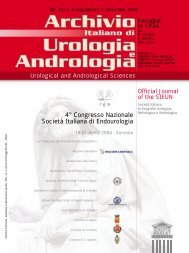7° Congresso Nazionale
7° Congresso Nazionale
7° Congresso Nazionale
You also want an ePaper? Increase the reach of your titles
YUMPU automatically turns print PDFs into web optimized ePapers that Google loves.
<strong>7°</strong> <strong>Congresso</strong> <strong>Nazionale</strong> Associazione Italiana di Endourologia<br />
Mini-percutaneous procedure (MIPP): a new set.<br />
Summary<br />
Antonio Frattini, Stefania Ferretti, Paolo Salsi, Umberto Maestroni, Pietro Cortellini<br />
Urology Unit, Azienda Ospedaliero-Universitaria of Parma, Italy<br />
Objective: We are presenting our instrumental set for mini-percutaneous procedure<br />
(MIPP-set), manufactured in collaboration with RÜSCH Medical Company, along with<br />
our indications and clinical experience.<br />
Methods: From January 2002 to December 2006, we treated with MIPP, 63 patients,<br />
range 2-76 years. Percutaneous lithotripsy was performed in 57/63 patients, for stones<br />
of 21 ± 10 mm burden; 4/63 pts underwent a new recanalization for uroenteric strictures in 3<br />
neobladders and 1 ileal conduit; in 1/63 pt was performed a L.A.S.E.R. ablation of a small<br />
superficial transitional cell carcinoma; in 1/63 pt was extracted a ureteral stent migrated to the<br />
pelvis.<br />
Results: For 57 nephrolithotripsy procedures stone- free rate was 98.3%; 1 patient needed stenting<br />
for hydronephrosis and in 3 patients were positioned a monoJ catheter for haematuria for<br />
some days, totally 7/63 pts were transfused (11%); the mean extimated blood loss was 0,65 ±<br />
1,05 g/dL HB (range 0,1- 3,9 g/dL HB); for residual procedures (6 patients) there were no complications;<br />
the mean hospital stay was 4,2 ± 2,8 days (range 2- 14 days).<br />
Conclusions: The limits of this technique are: major operation times and consequently major<br />
costs; more difficulties in vision and operability. The advantages are: less trauma, reduction of<br />
bleeding, possibility of tubeless procedures and shorter recovery times. Supine position is certainly<br />
a step forward in terms of reducing operative times and percentage of clearance of the<br />
fragments. The progress mainly in optics and the miniaturization of instruments will make the<br />
procedure more useful and effective.<br />
KEY WORDS: Minipercutaneous procedure; Percutaneous nephrolithotripsy; MIPP-set; MINI-perc.<br />
INTRODUCTION<br />
Percutaneous nephrostomy procedures are generally<br />
safe. The associated mortality rate is approximately<br />
0,04% and the incidence of important complications is<br />
about 5%. But, if we consider other aspects such as: hospitality<br />
time, post-operative pain, patients with coagulation<br />
diseases or renal abnormalities or transplanted kidney,<br />
the minimal nephrostomy procedures are advisable.<br />
We are presenting our instrumental set for mini-percutaneous<br />
procedure (MIPP-set), manufactured in collaboration<br />
with RÜSCH Medical Company, along with our<br />
indications and clinical experience.<br />
METHOD AND MATERIAL<br />
We consider Minimal Percutaneous approach, a<br />
nephrostomy tract equal or less than 14 Fr (inner diameter).<br />
Our dilation set (MIPP PU/PVC by Frattini-<br />
Cortellini) consists of : a 17,5 Gauge needle, a 0,035 inch<br />
guide wire Lunderquist-type, 2 coaxial hydrophilic dilators<br />
(9,14 Fr), a 14 Fr Amplatz sheath and a 12 Fr silicone-<br />
coated nephrostomic catheter with metallic gauge<br />
(Figure 1); the operative instruments should be a 11 Fr<br />
Figure 1.<br />
The MIPP set.<br />
Archivio Italiano di Urologia e Andrologia 2007, 79, 3, Supplemento 1<br />
43



